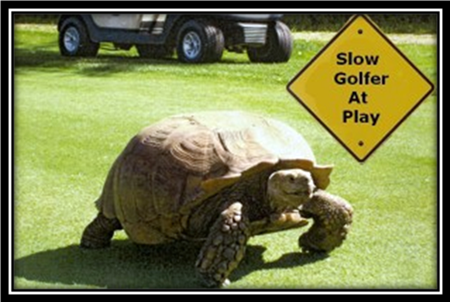Welcome to Golfnutter’s Blog – a weekly commentary highlighting contemporary golfing issues, in Pattaya and beyond. For more on matters golf, go to www.golfnutter.wordpress.com.
Freddie the Farang of Pattaya loves his golf. He takes it seriously too. He’s always watching the pros on TV, seeing if he can’t build something else into his pre-shot routine. Freddie, handicap 25, often copies other player’s routines, especially if they are low-markers.
According to the US National Golf Foundation, the number of rounds played in the US each year, in the ten year period ending 2011, went from 518,000,000 down to 463,000,000. The main reason given was pace of play.

There’s nothing wrong with a 25-handicapper trying to emulate a 5-handicapper’s pre-shot routine, unless that routine is abnormally long. Similarly, average golfers imitating pros, in terms of pre-shot deliberations, need also be aware of the cost in time. The problem arises when the long-marker believes he is no slower than the short-marker simply because they have an identical pre-shot routine. What this assumption ignores is the 20 plus additional shots the long-marker will play. Aggregate time spent playing 18 holes is the issue here. The difference time-wise can be huge. This factor is often overlooked when pointing the slow-play finger.
Another reason for slow play, and it’s one we can do nothing about, is playing behind five or six-balls. Leaving aside the fact this is only an occasional event, and that some Thai five-balls are faster than many Farang four-balls, the truth of the matter is that this is not the main reason for slow play. The real culprit lies within our own ranks. It is us, or at least those of us who for whatever reason are slow.
Having lost ground to the field, what can a four-ball do to pick up its pace? The trick here is to recommend actions that do not impact on existing pre-shot routines, so it’s not a big deal, yet. This is phase one. Phase two is best done over a beer.
- If playing stableford, have players pick-up when their score on any one hole exceeds net one-over-par. At this point their stableford score for that hole will be zero.
- Introduce “ready golf”; a common term used to encourage whoever is ready to go ahead and play their shot, whether it’s their turn or not.
- As soon as the first player putts out, have them proceed to the next hole and tee off, immediately.
- Encourage players not to mark their cards when it’s their honour. Have them tee-off first.
- While waiting on the tee, or at any point through the green, work out what club you are going to play, and how. When it comes to your turn, you should be good to go.
- If you need to read your putt from the other side of the hole, do so while waiting your turn.
- Pay attention to the line of tee shots, not just your own.
- If doubt exists over whether a ball is in play, or may be difficult to find, always play a provisional ball. Please note if your ball is believed to be in a hazard, the Rules do not permit the playing of a provisional ball. If you’re playing with a PSC group, however, your Local Rules state you must play a provisional ball, regardless.
- If carting on a day when they are restricted to cart paths, please, please take more than one club with you when unsure of your lie or distance.
- People sharing golf carts should use them as a way to play faster, not as a way to be lazy and selfish. If four guys are playing in two carts, it is not necessary to drive to everyone’s ball. The player playing second can grab a few clubs a walk rather than wait.
Realise this, you could be a scratch or 30-handicapper, it matters not. In the minds of many golfers it is how long they perceive you take when it is your shot that will form their view – notwithstanding aggregate time taken. But also realise that a golfer has every right to a routine, even a meticulous one, if it means he increases the chance of keeping his ball in play. The same tolerance need not be applied around the greens.
Appreciate that the new golfer in your group may never have received tuition on pace of play. If this appears the case, then it is beholden upon the experienced golfer to pass on appropriate guidance.
As for Freddie, he can employ whatever pre-shot routine he likes, so long as he realises the total time that routine requires to play a hundred shots.
One great tip for saving time on putting greens – watch the world’s number two-ranked golfer next time he is on TV and copy his putting routine, his practise putting stroke in particular.



